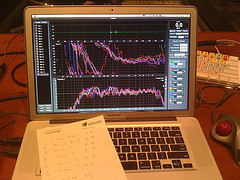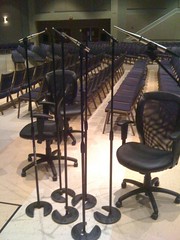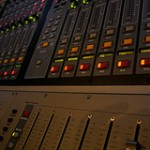
Year of the System 2010: Getting Smaarter
So the new system has been an interesting animal. I’m currently in a love/hate phase with it. Don’t get me wrong, though, it is a great system. However, the detail and accuracy of the rig has really forced us to rethink a lot of things and while I just want to sit down and make music with the thing I hate that I’m having to think so much.
I can’t tell you how many times we tuned the thing because I’ve lost count at this point. The system processors were clean when we started, and there are now maybe 25-30 different snapshots of settings stored; that’s probably an exaggeration, but there are a lot. All I know is we’ve bounced around back and forth between different settings intermingled with tuning from scratch. The good news, though, is we’ve been settled in on things for about a month now.
It’s hard to explain why we’ve played around so much. Part of it was probably based on initial expectations and the perception we weren’t hearing things so let’s try and re-tune to get that stuff out. Maybe some of it was probably confusing what should get done in the system vs. what should get done on the mix side. Then there’s the “I don’t want to do it this way so let’s do it that way.” And of course don’t forget pure experimentation for the sake of science. Conforming things to tastes was another thing. And then there’s the simple fact that we’ve got the tools and the ability to go backwards if we make it worse so why not try and see if we can make it better. And we DID go backwards through the whole process.
In fact, the “tuning” we’ve been working off of for several weeks now is the same one that our campus audio staff guys did the week before Drive and was the second time we tuned the PA. There have been some little tweaks Luke and I did thrown in here and there, but the core of it is what Dustin, Briley, and I did right before Drive. It was good before we put our hands on it, but I think those guys definitely helped us get closer to where we want to be thanks to their experiences working with the other campus rigs.
So what was wrong that drove us to tune tune tune? Well, I wouldn’t say it has been a case of correcting a wrong as much as it has been a case of refining things which is really a multi-part process. Part of it is simply figuring out how to mix on the thing and part of it is tweaking the rig so we can figure out how to mix on it. Sometimes you try and make it work in the mix, and then sometimes you figure it’d be better to just do it at the system level. There have also been little things like smoothing transitions between zones and lots of taste stuff, but really I think it has come down to the simple process of wrapping our heads around the new. It’s a new car that handles differently than the last one, and we’re moving to the place where the driver and vehicle are both singing one week at a time.
I’m going to save some of the specific challenges and what I’ve been going after for another time, but before I wrap this up I do want to highlight something that has been a major player in all the system work we’ve done. Rational Acoustics released Smaart 7 right about the time we were putting in the PA’s, and the timing was perfect. I don’t think we could have gotten the PA where it is right now without Smaart 7.
One of the realities of dealing with a large system is the interaction that takes place between elements. Whether it’s working with line arrays or a large distributed system, the fact is that there are a lot boxes making noise and in an enclosed space they will interact. Hopefully the system is designed so that interaction happens when we want it to and destructive interference is minimized. The beauty of Smaart 7 is now we can run multiple transfer functions in real-time. That means we can put as many mics up as our processor and audio interface will support and watch them at all times. While it’s true that most FFT software out there will let you store a measurement trace to refer to while you work on a new location, I just don’t think it’s the same as having everything running in real time.
When I last took a stab at tweaking the system a few weeks ago, I literally had 7 mics set up. That’s one mic for every “zone” on our main floor(including mix position) from the front of the room to the back. Sure it takes a little more time to setup, but it’s so worth it. With Smaart 7 I can see how the line array is working front to back along with the frontfill and downfill zones. I can work on one zone at a time or multiple zones and see exactly how it’s affecting everything else. This makes it a lot easier and faster to make the necessary compromises to even the response front to back.
Once the mains are good, the same principle applies to working on fill zones and the transition between them. Now I can leave a mic up for the mains while putting more mics in the fill zones to see what happens. With all the low frequency drivers we’ve got up in the air, it’s inevitable that things are going to interact, and now I can see it in real time. Also, by calibrating all my mics before getting started the measurement traces also reveal SPL differences throughout the room which again made it a lot easier to get things closer in a shorter amount of time.
If you’ve been thinking about upgrading to Smaart 7, now really is the time to do it. Rational Acoustics still has early adopter pricing going until July 15, and I’d encourage you to check it out while there’s still time. Over the last couple years I’ve gone back and forth between Smaart 5 and 6 to do things along with playing with SysTune, but I think I’m going to be staying in the Smaart 7 camp exclusively for the foreseeable future. There’s a reason why Smaart has been considered something of an industry standard, and I think they’ve definitely raised the bar this time out.



 Previous Post
Previous Post Next Post
Next Post


